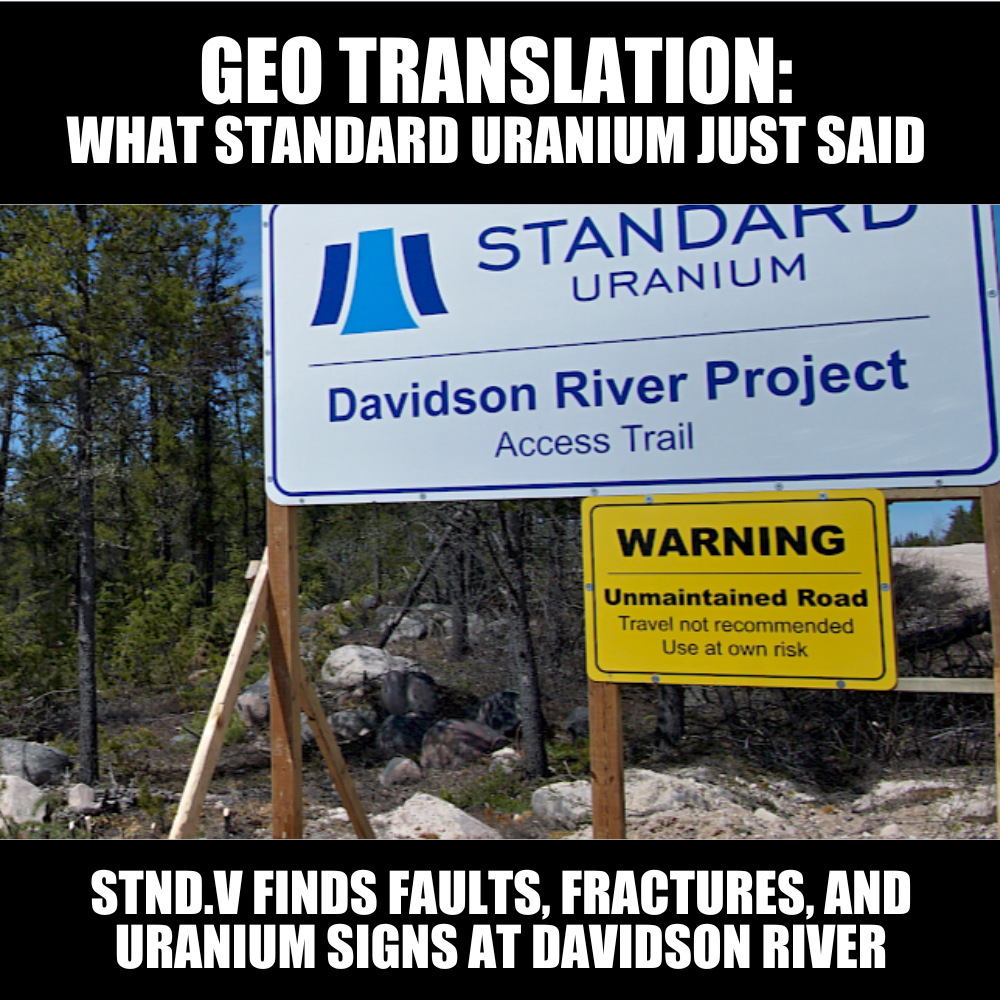 Disclaimer: This article has been paid for by Standard Uranium. See disclosures at the bottom of the page.
Disclaimer: This article has been paid for by Standard Uranium. See disclosures at the bottom of the page.
Mining exploration terminology is often completely incomprehnsible to the layman investor. Sure, you know uranium is hot and you want to figure out which explorer is doing what so you can put some money in, but then comes the sort of news releases that, by regulatory decree, have to sound like the following, put out today by Standard Uranium (STND.V) around their flagship Davidson River project:
- Successful ExoSphere Multiphysics surveys: Combined 3-D ambient noise tomography and horizontal-to-vertical spectral ratio velocity models and constrained ground gravity block models have been generated on the Warrior, Bronco and Thunderbird trends, providing critical subsurface information for guiding continuing exploration across the project.
To be clear, that’s good news. But how good exactly?
Knowing the answer to that requires the ability to translate from rock language to human language.
Now, I’ve been writing about resource companies for a dozen years and I’m not a *complete* dummy, but that company wordage above is a sentence I had to re-read several times and, if I’m honest, do a bit of googling over, in order to really understand it properly.
It’s not the company’s fault, mind you. They have to be super careful how they phrase their information, and anything they put out has to get approved by the exchange and IIROC and lawyers, and how things are worded in that news release is a subject that leaves all parties SUPER persnickitty.
Try to make things too understandable to the layman and the pointy headed folks on high demand changes. And that means another round of approvals. And maybe added legal expense. And most certainly time.
So companies revert to what they know will be approved; that is, super geologically precise terms that don’t leave any wiggle room for understanding, and go nowhere near ‘hype.’
SO WHAT DOES IT ALL MEAN?
The actual news release is as follows, and to help you get what’s being said, we’ve built a series of ‘tool tips’. Just hover your mouse over a bolded link and you’ll see a box that explains the terminology better.
Successful ExoSphere Multiphysics surveys: Combined 3-D ambient noise tomographyA seismic imaging method that “listens” to natural ground vibrations to build 3D maps of rock layers and horizontal-to-vertical spectral ratio velocity modelsA tool comparing wave movement sideways vs. down to reveal weak or fractured zones underground and constrained ground gravity block modelsGravity surveys mapped into 3D blocks showing density changes, cross-checked with other data for accuracy have been generated on the Warrior, Bronco and Thunderbird trends, providing critical subsurface information for guiding continuing exploration across the project.
Critical vectors for high-grade uranium: Distinct gravity-low anomaliesAreas where gravity is weaker than expected, often caused by less-dense altered rock linked to uranium. representing potential hydrothermal alteration zonesRock changed by hot, mineral-rich fluids — a common process around uranium systems. have been identified across all three surveyed structural corridorsMajor underground fault or fracture belts that guide fluid flow and mineralization., overlapping known electromagnetic (EM) conductorsZones that carry electrical current well, often associated with uranium-hosting rock types., extrapolated basement faultsDeep geological faults projected from earlier drill results across the area. from previous drilling and basement velocity lowsPlaces where seismic waves slow down in the deep rock, often indicating fractured or altered zones., marking structural disruption and/or favourable lithological contrastsSharp changes between rock types that can trap mineralization.. Multiple new targets also coincide with defined EM SmartMatch targetsMachine learning results that flag anomalies resembling known uranium deposits. provided by ALS GoldSpot based on anomaly matching to the Arrow depositOne of the Athabasca Basin’s largest high-grade uranium discoveries. and Triple R depositA nearby world-class uranium deposit used as a comparison model..
Fall 2025 drill program: The company has secured drilling permitsOfficial government approvals required before drilling can begin. and executed exploration agreements with its Clearwater River Dene Nation partnersLocal Indigenous community agreements ensuring collaboration and benefits.. With vendors in placeContractors, drill crews, and suppliers secured and ready., the company is planning a four- to six-week drill program scheduled to commence in early September, 2025.
LET’S GET EVEN CLEARER
PARAGRAPH ONE:
Standard used advanced sound- and gravity-based tools to make detailed underground maps of three target areas (Warrior, Bronco, Thunderbird). Usually, the rock over the uranium interferes with magnetic signal and muddles what might be lying underneath, which means the explorer has to drill – which is expensive and time consuming – to understand the lay of the land better. STND is using new tech that doesn’t just go down, it also goes sideways, allowing them to hopefully triangulate the signal better before drilling is required. This gives them a clearer picture of where to look for uranium.
PARAGRAPH TWO:
The surveys found zones of weaker gravity and fractured rocks that suggest uranium-related alterations are in place. These line up with known conductors, faults, and rock breaks, which backs up the thinking that the sort of rock that uranium is often found in, is right there where Standard is looking for it. AI analysis confirmed that several targets look very similar to world-class uranium deposits nearby, making them high-priority drill spots. This is good news.
PARAGRAPH THREE:
All permits and Indigenous agreements are secured, contractors are ready, and drilling will start in September 2025 to test the new targets.
DOESNT THAT MAKE MORE SENSE?
Sho nuff.
The news release goes on to say:
Along each of the Warrior, Bronco and Thunderbird conductive trends, multiple gravity-low anomalies have been identified from constrained density models. These anomalies overlap with known EM conductors, extrapolated oriented core shearing/faulting and abrupt ANT-HVSR velocity anomalies that may represent basement wedges or vertically offset faulting, typical structural traps for uranium mineralization. Additionally, where these potential structures intersect gravity-low anomalies, they may indicate structurally focused hydrothermal alteration, such as clay replacement, which is commonly associated with basement-hosted uranium mineralization. The intersection of these geophysical anomalies with modelled graphitic shear zones results in multiple highly prospective drill target areas.
Or, in layman’s terms of five words or less:
Faults plus fluids = uranium (probably).
— Chris Parry


Leave a Reply